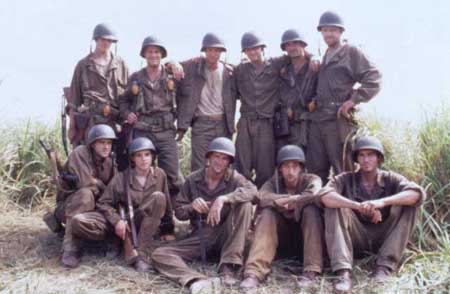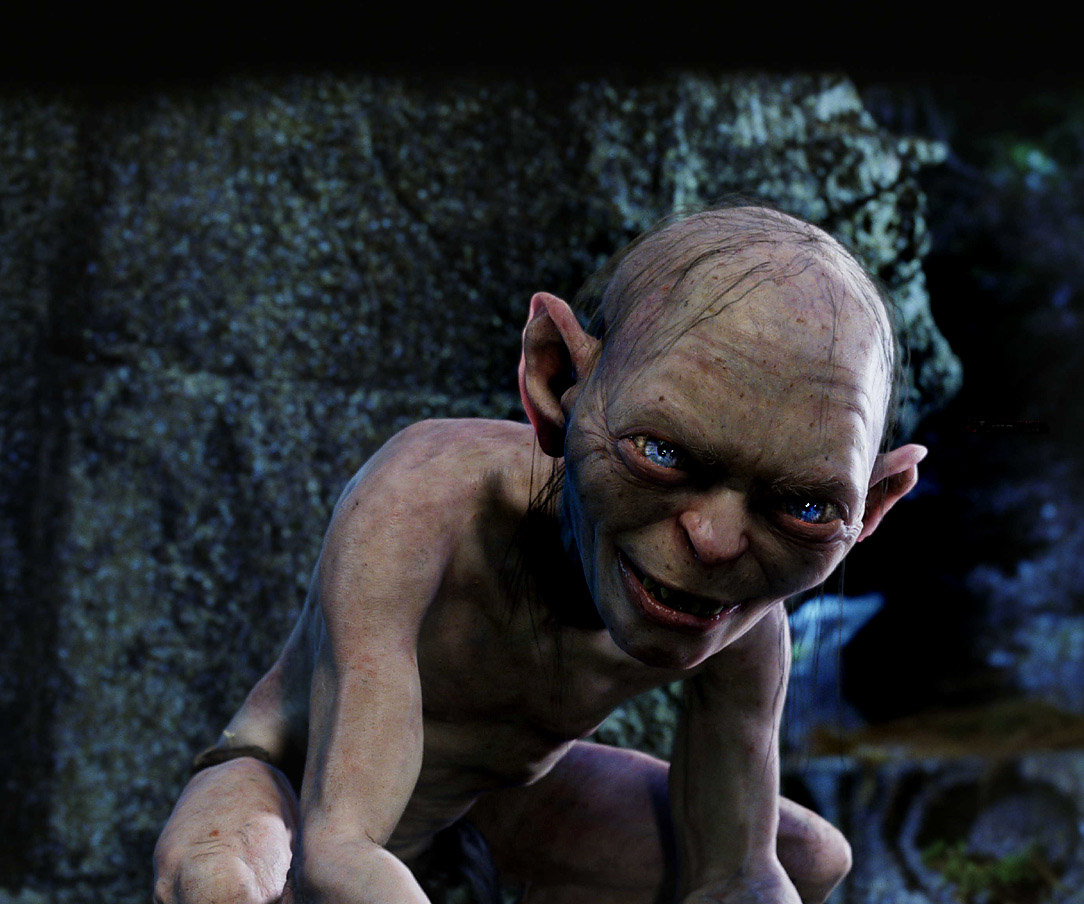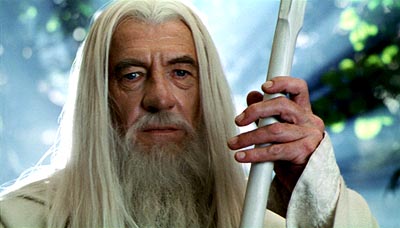
So the main reason it’s been so quiet around here this week is that, through a fanboy nation connection that shall remain safely anonymous, I’ve managed to procure a copy of the Two Towers Extended Edition two weeks before its release date. The rest of this post is going to involve considerable spoilers, so if you don’t want to know, just skip on down to the next entry.
The film: As in the longer Fellowship, the additional 43 minutes of the extended Two Towers mostly offers new character beats (for example, as in FOTR:EE, hobbits now act more like hobbits) and a more languid pacing in various locales (such as the Dead Marshes, where new footage helps lend the feeling that it’s not just a hop-skip-jump from the Emyn Muil to the Black Gate.) And as with FOTR, I think after a few viewings that almost all of the inclusions help the film — in fact, some even seem necessary.
What exactly is new, you may ask? Well, I don’t want to give away everything, but both the beginning and the end of the film have been extensively reworked. Frodo and Sam now spend more time lost in the Emyn Muil, using Galadriel’s rope to climb down a jagged rock face, looking gloomy in the rain, and exchanging a Shire moment over a little box carried by Sam (I had hoped that it might be full of seedlings and dirt, but alas, it’s just salt.) Smeagol and Gollum get into it earlier now too, arguing over whether to honor an oath made on the precious. And we see more of Merry and Pippen’s Uruk-Hai captors, and why they turn on each other so quickly at the borders of Fangorn (The reason in the book is alluded to but not specifically stated.)
As for the end, the inclusion to Helm’s Deep noted here is indeed present. Also, Merry and Pip indulge in some Flotsam and Jetsam-style pipeweed shenanigans, and Faramir sends off Frodo, Sam, and Smeagol with a word of warning about the caverns near Cirith Ungol (This last part is troubling to me, actually, since it occurs before Gollum talks about her. Of course, Gollum’s had the plan all along – perhaps he’s just letting Smeagol know in the final scene. Still, Faramir’s comment seems like premature foreshadowing.)
In between, there are a number of small and moderate changes along the way. Faramir is fleshed out more — word has been out for awhile about his flashback scene with Boromir and Denethor, and he also gets to ruminate on the death of a Southron, as in the book. Those who found his characterization jarring in the theatrical release, however, will probably still feel that way — particularly after you see what the Men of Gondor do to Gollum on Faramir’s watch. Over on the Rohan side of the Anduin, Theodred’s death is given more dramatic weight, and Eowyn is given some nice character beats — one in which she complains about getting cooped up in the Glittering Caves, another where she stumbles onto Aragorn’s real age (87, important because it establishes Aragorn as being not only Numenorean but also between worlds…he’s too old for Eowyn and too young for Arwen.) Finally, fans of the Ents will be greatly enthused by the Extended Edition — there’s several more scenes involving Treebeard & co., and one very nice nod to the Old Forest of Tom Bombadil that really should’ve made the original cut.
As for me, my favorite inclusion at the moment is two scenes involving Gandalf (one of which was featured prominently in the original 4-minute preview and the TTT video game.) I thought these two scenes — where Gandalf discusses his broader strategy against Sauron and Saruman’s machinations (something notably missing in the theatrical release) — helped to tie the first two films together and passed along information that seems absolutely crucial to non-readers of the trilogy.
The Extras: Owners of the extended Fellowship won’t be all that surprised by what’s on the second set of discs — exactly the type of well-made, in-depth documentaries that we’ve come to expect. What may be most interesting here are the claims by multiple people that the post-production on TTT was a “nightmare,” the most stressful point in the entire making of the trilogy. I haven’t watched nearly all the extra stuff yet, but some of the enthralling discoveries made so far include:
- Small glimpses of RotK footage, including a nice pan over Cirith Ungol in the Tolkien documentary and unfinished footage of Gandalf & co. approaching Isengard in the book-to-script video. Update: Footage which, as it turns out, they might as well have kept in Towers after hearing this shocking revelation about who’s been cut from the theatrical release of RotK. Trust PJ and all that, but still…this is bad news. I wonder how they’ll manage to introduce Pippen and the palantir now.
- Intriguing discussion (by Tom Shippey and others) on the Dead Marshes as indicative of Tolkien’s memory of WWI battlefields.
- The revelation that a longer Gandalf-Balrog battle, including an underwater fight and the Endless Stair, was stripped out due to CGI “budgetary constraints” (Budgetary constraints? Are you kidding me? C’mon, y’all, you’ll make it back.)
- Lots of funny and/or revealing interactions between members of the cast, including Viggo Mortensen’s penchant for painful head butts at inappropriate times, a Serkis-Astin feud at the Black Gate involving a hobbit wig, and the bicycle seat torture inflicted by Misters Monaghan and Boyd by a colossal Treebeard puppet.
- A honest discussion about the changes made from book to script for the Two Towers, one that explicitly notes fanboy discontent over Faramir’s shift and Arwen’s early role at Helm’s Deep. (Apparently, Liv Tyler cried after reading snide comments about “Liv Tyler, Warrior Princess” all over a fan site — most likely AICN, since that used to be posted all over the place there.)
- A fascinating look at Elijah Wood in evil, Gollum-like make-up, from a deleted scene which would have occurred in the supply cave, after Frodo snatches the ring away from Faramir’s sword.
- The Gollum acceptance speech at the MTV Movie Awards, occupying the Easter Egg spot where the Buffy ‘n’ Black Council of Elrond parody resided on FotR.
The Upshot: All in all, as with Fellowship, the extended Two Towers DVD includes a better, richer film loaded with tons of fascinating extras. If you’re a fan, I’m sure you’re getting it anyway…but if you’re a casual Rings admirer, the TTT:EE is just as worth picking up as the FOTR:EE. And they look great together on the shelf.
Now, does anyone out there have tix to an advance screening of Return of the King…?


 1) Gollum (“Leave and never come back!“): My biggest concern entering the back-end of the trilogy was that Smeagol would come off cartoony and Jar Jar-ish. He doesn’t…at all. (As one wag put it, the Jar Jar in this film is Gimli.) In fact, I’d say Smeagol’s moonlit and schizophrenic soliloquy stands as the showstopping highlight of a film filled with amazing moments and indelible images. Kudos to Andy Serkis and the WETA gang for what they’ve done here. By the end, I wanted to see more Gollum and less preparation for Helm’s Deep (But to be fair that’s the same problem I have with Tolkien’s book – The events east of the Anduin seem so much more interesting and important due to the presence of the ring.) And, speaking of the eastern theater…
1) Gollum (“Leave and never come back!“): My biggest concern entering the back-end of the trilogy was that Smeagol would come off cartoony and Jar Jar-ish. He doesn’t…at all. (As one wag put it, the Jar Jar in this film is Gimli.) In fact, I’d say Smeagol’s moonlit and schizophrenic soliloquy stands as the showstopping highlight of a film filled with amazing moments and indelible images. Kudos to Andy Serkis and the WETA gang for what they’ve done here. By the end, I wanted to see more Gollum and less preparation for Helm’s Deep (But to be fair that’s the same problem I have with Tolkien’s book – The events east of the Anduin seem so much more interesting and important due to the presence of the ring.) And, speaking of the eastern theater… 4. Gandalf the White: (“I did not brave fire and death to bandy craven words with a witless worm.”) The transition (and dislocation) from grey to white was handled quite well, I thought, and Ian McKellen was superb once again. I’m even more annoyed now with the Academy for passing him over last year in favor of the admittedly good Jim Broadbent (who won for Iris but no doubt got most of his votes for Moulin Rouge), since the Gandalf scenes are too slim here to warrant nomination.
4. Gandalf the White: (“I did not brave fire and death to bandy craven words with a witless worm.”) The transition (and dislocation) from grey to white was handled quite well, I thought, and Ian McKellen was superb once again. I’m even more annoyed now with the Academy for passing him over last year in favor of the admittedly good Jim Broadbent (who won for Iris but no doubt got most of his votes for Moulin Rouge), since the Gandalf scenes are too slim here to warrant nomination.